Arts & Entertainment Community
Day Tripper | Beginning a Puget Sound Loop
I know. This is Day Tripper. I’ve established limits: No more than 100 miles each way, and an adventure that can be accomplished in just one day. Each of my destinations is just that, a one-day trip that does not exceed 200 miles total, out and back again.
I’ve been thinking about places I want to take you to over the next few months. For quite a while now, I’ve wanted to investigate some of Western Washington’s legendary lighthouses. There are several I’d like to see, but I was leaning toward starting with the Mukilteo Lighthouse and Lighthouse Park.
I have a couple of other adventures planned for later in 2024. Included are a trip to the south end of Whidbey Island and an exploration of the Port Townsend area.
As I was consulting the great Google and its offspring, Google Maps, I realized that while each of these trips qualifies as a stand-alone day-trip, I could also combine them and make one giant loop. A super-day-trip? At 164 miles on the road, and just over 4 hours of drive-time (plus ferry wait time), I could, if I chose to, kill three birds with one stone.
After some reflection, I decided it was more likely that it would be the trip that killed me.
Recently, I had to drop family off at Everett’s Paine Field airport. As I left this compact little airport, I noticed that I could turn right and get back on southbound I-5, or I could turn left on Highway 525 and go check out Mukilteo. I turned left. Research on Phase 1 of the Great Puget Sound Loop had just begun.
I spent the afternoon and evening (thank you daylight savings time!) investigating all that this special little community has to offer. As usual, once I was in Mukilteo I found several other areas that were too intriguing not to investigate, so let’s check it out.
Mukilteo’s backstory
Mukilteo and Gig Harbor are very similar communities. Mukilteo is a waterfront community located about 25 miles north of Seattle, just south of Everett on Possession Sound in Snohomish County. The first settlement in the county, it was the original county seat.
Like so many other coastal communities, it was originally established to provide a home for a port, trading post, and lumber mill. Some say that the community’s Native American name can be roughly translated as “good camping ground,” although today 21,000 people have decided to stay and now call Mukilteo home.
Mukilteo is the location of the signing of the Point Elliott Treaty in 1855. Long the home of the Snohomish Tribe of Indians, the treaty sealed an agreement between territorial governor Issac Stevens and 82 Native American leaders, including Chief Seattle, ceding the land to the United States Government in exchange for relocation to reservations, retention of hunting and fishing rights, and cash.
As the Puget Sound area grew, so did Mukilteo, with various businesses established between the middle of the 1800s and the beginning of the 20th century. In 1906, the Puget Sound and Alaska Powder Company was established, and the Mukilteo Lighthouse began operation. In 1930, the powder plant exploded, but the lighthouse has remained an important architectural landmark since its construction. Now on the National Historic Register, it sets the tone for the Mukilteo waterfront.
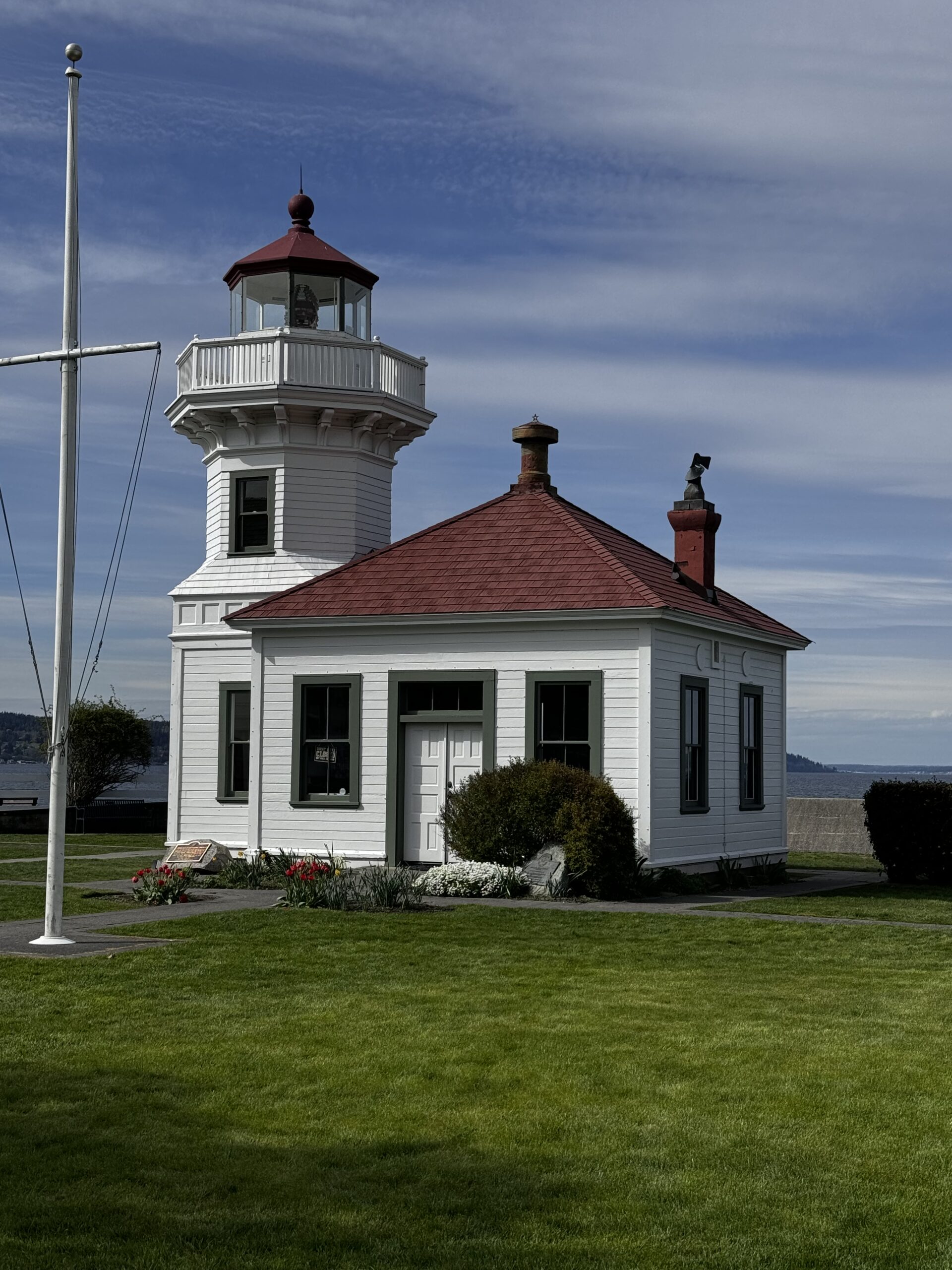
Mukilteo Lighthouse
The Lighthouse and its Park
You can’t find the Lighthouse without finding Lighthouse Park.
After the construction of the Mukilteo Lighthouse in 1906, the area surrounding it was converted into a baseball field when the people of the town built a dike. Tidal surges and storms eventually did it in, and maintenance was abandoned, causing the land to deteriorate. In 1950, the state decided to do something about it and trucked in loads of dirt to create a state park. In 2003, the state dedicated the property to the city of Mukilteo, which renamed it Mukilteo Lighthouse Park, and continues to maintain it today.
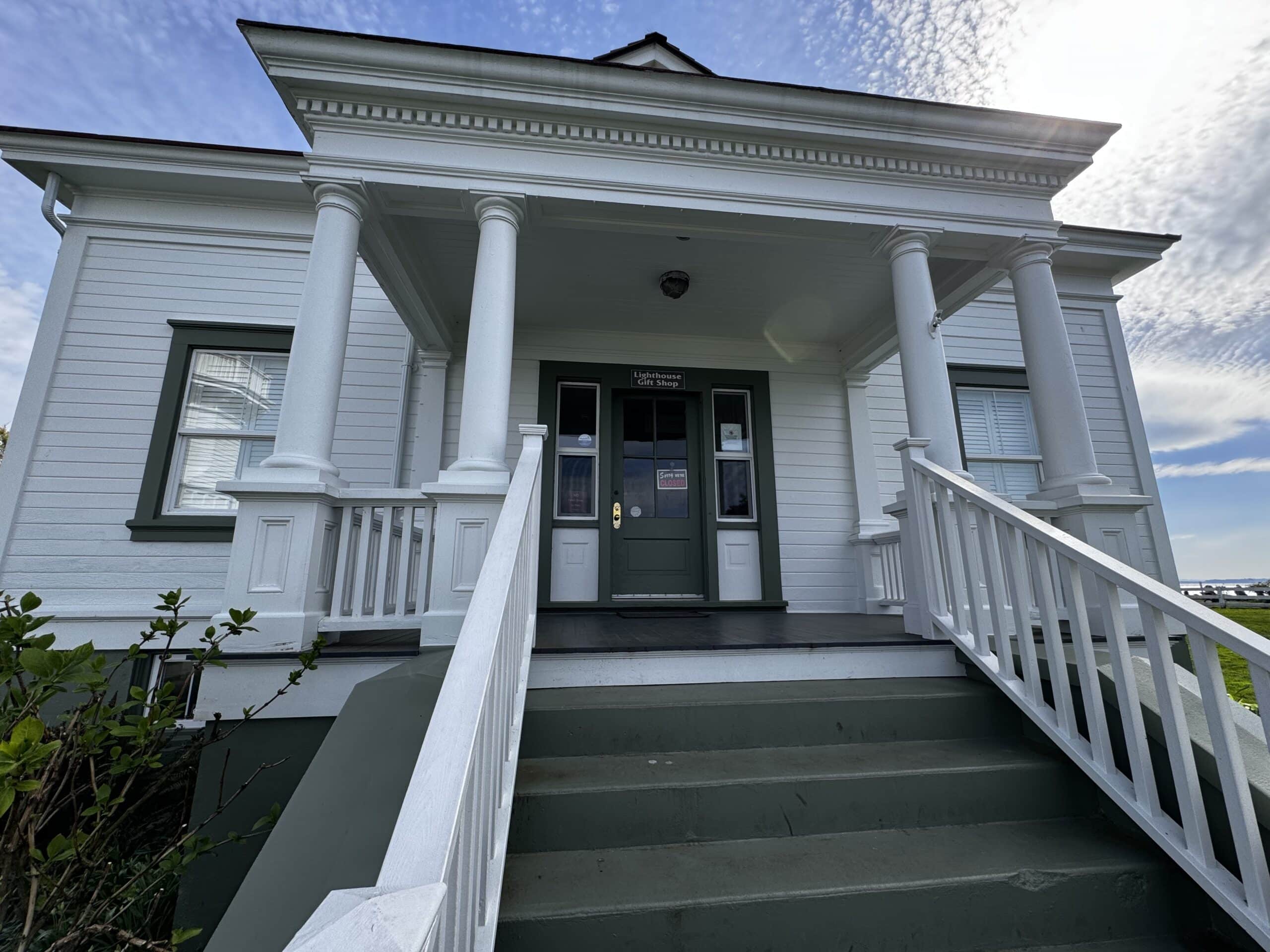
The assistant keepers house
The anchor of the park is, of course, the Mukilteo Lighthouse, which included a home for the keeper and his family, and is surrounded by the homes that were built for the two assistant keepers. The city and the Historical Society have created a Walking Tour brochure which explains the significance of each of the tour’s 14 stops.
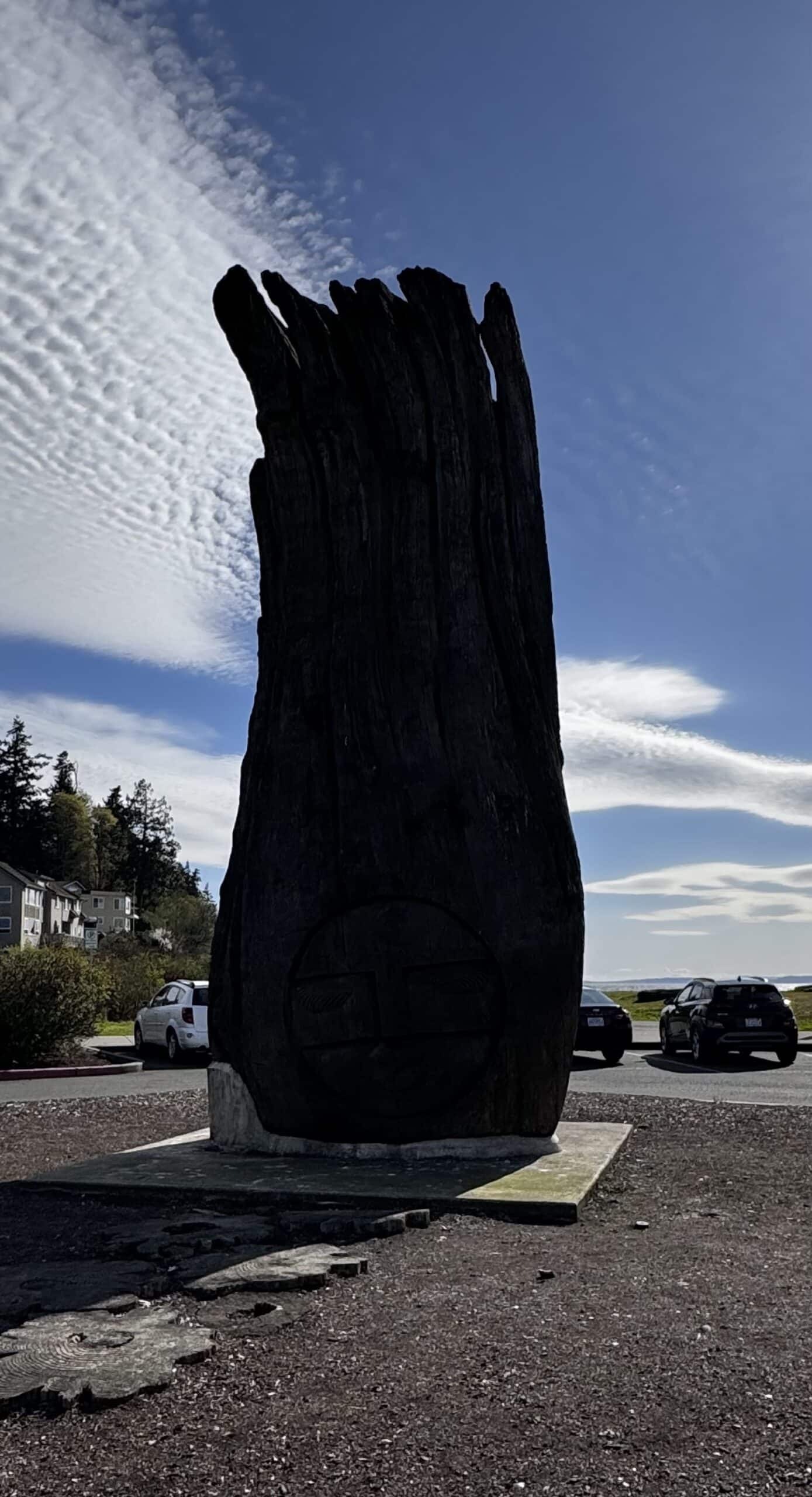
The driftwood scultpure
Be sure to check out the wedding circle, the driftwood sculpture, and the many seating areas where you can enjoy the expansive view of the mountains, Whidbey Island, and the sea life that frequents the beach. On a clear day, the views are incredible.
The park also includes restrooms, a plethora of picnic tables, and a covered picnic area. There are lots of places to throw a frisbee and a playground where smaller kids can play.
The Mukilteo Lighthouse is one of the most visited in the state. Owned by the city and operated by the United States Coast Guard, it was first lit in 1906. Standing 38 feet tall, it was automated in 1979, and a remote fog sensor was installed in 1981.
The USCG installed a LED light source in 2022. The light flashes once every 5 seconds, complying with the current signature flash mandated by the Coast Guard. The LED light provides a brighter white light than the previous halogen bulbs guiding vessels into the Sound, including the nearby Washington State ferry.
The Mukilteo Lighthouse Festival Association supports the operation of the Lighthouse and sponsors a festival in the autumn. This year’s festival will be on Sept. 6 through 8. Click here for more information.
Ivars Mukilteo Landing
We all know about the Ivar’s restaurants on the Seattle waterfront, and have heard about the many things there founder, Ivar Haglund, has done for the Seattle community. But did you know there’s a third Ivar’s full-service facility? It’s right there in Mukilteo, just down the street from the lighthouse.
With an expansive view of the entire sound, it provides a premier location for watching ferry traffic transverse the short distance between the nearby terminal and the community of Clinton on Whidbey Island. If sit-down dining isn’t what you had in mind, there is also a walk-up bar where you can pick up a cup of chowder or some clams.
Lunch service runs from 11 a.m. to 4 p.m. Dinner is Sunday through Thursday 4 to 8 and 4-9 on Friday and Saturday. Happy Hour is daily 3 – 6 p.m. and 8-9 on Friday and Saturday. 710 Front Street, just next to the ferry dock.
Ferry Terminal
After 44 years of planning and construction, it would only have been fitting for the community to throw the new Mukilteo multimodal ferry terminal a huge party when it finally opened in December 2020. The pandemic took care of that. The terminal, passenger walkway, and supporting infrastructure quietly opened in spring 2021.
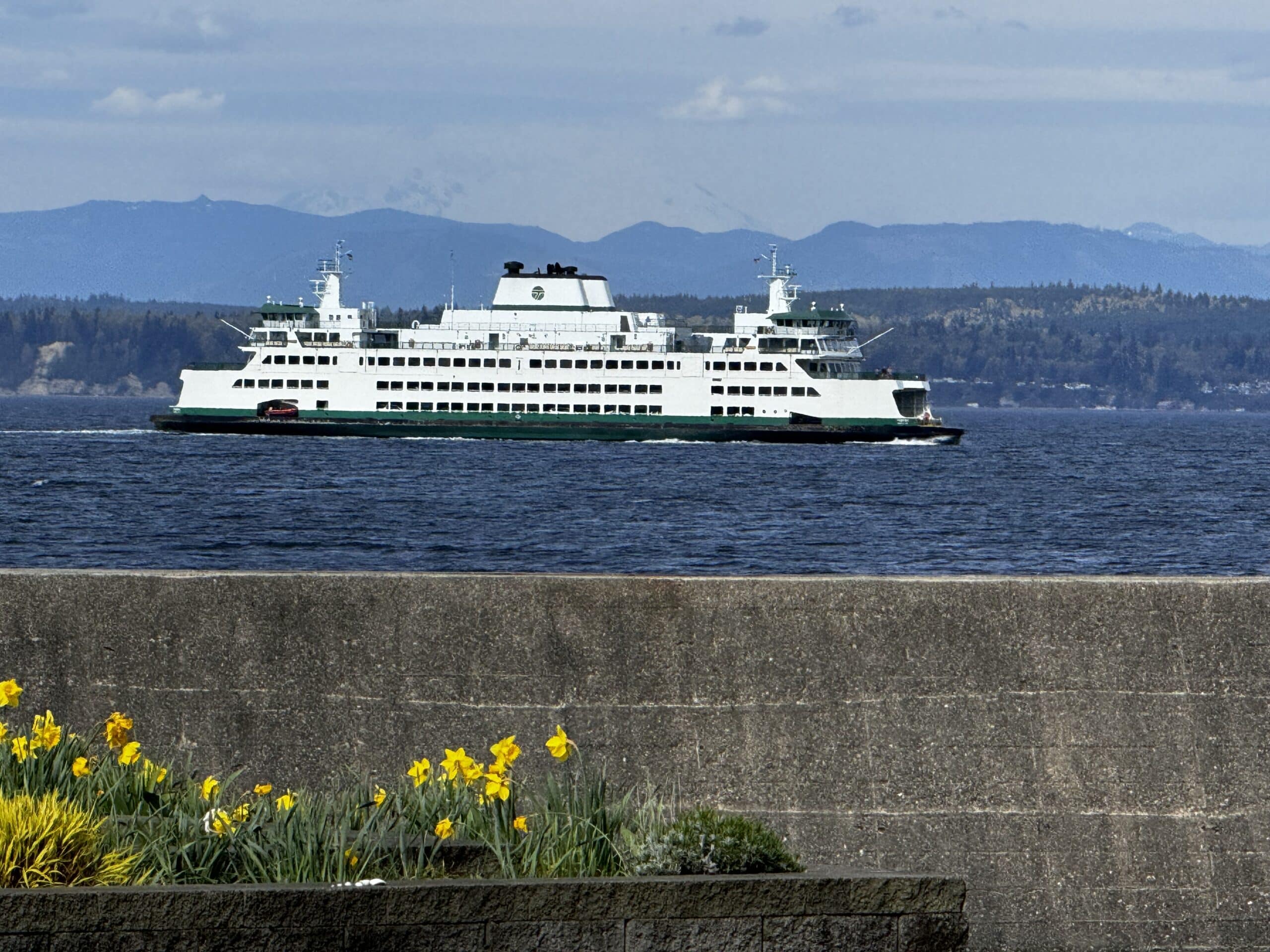
A Washington State Ferry between Mukilteo and Clinton on Whidbey Island.
The project began when the ferry system acknowledged that the existing terminal was not adequate for the amount of traffic that used it. WSF says that the Mukilteo/Clinton ferry route, which is part of Highway 525, is the major transportation corridor connecting Whidbey Island to the Seattle-Everett metropolitan area. It is one of the state’s busiest routes, with more than 4 million total riders every year. The existing terminal also did not meet required seismic standards.
The site of new terminal, one third of a mile east of the old location, is historically significant to local tribes and is the place where the U.S. government and local tribes signed the Point Elliott Treaty in 1855. It previously housed a U.S. Air Force fueling station, abandoned after the Cold War.
The first phase of construction removed an old 1,360-foot fueling pier that sat on 3,900 creosote-treated timber pilings. Removing the pier extracted 7,000 tons of toxic debris from Puget Sound.
The new award-winning terminal is designed in the form of a Coast Salish longhouse, is built to LEED Gold standards, and honors the tribal history of the site. The cost of the project was $187.3 million dollars.
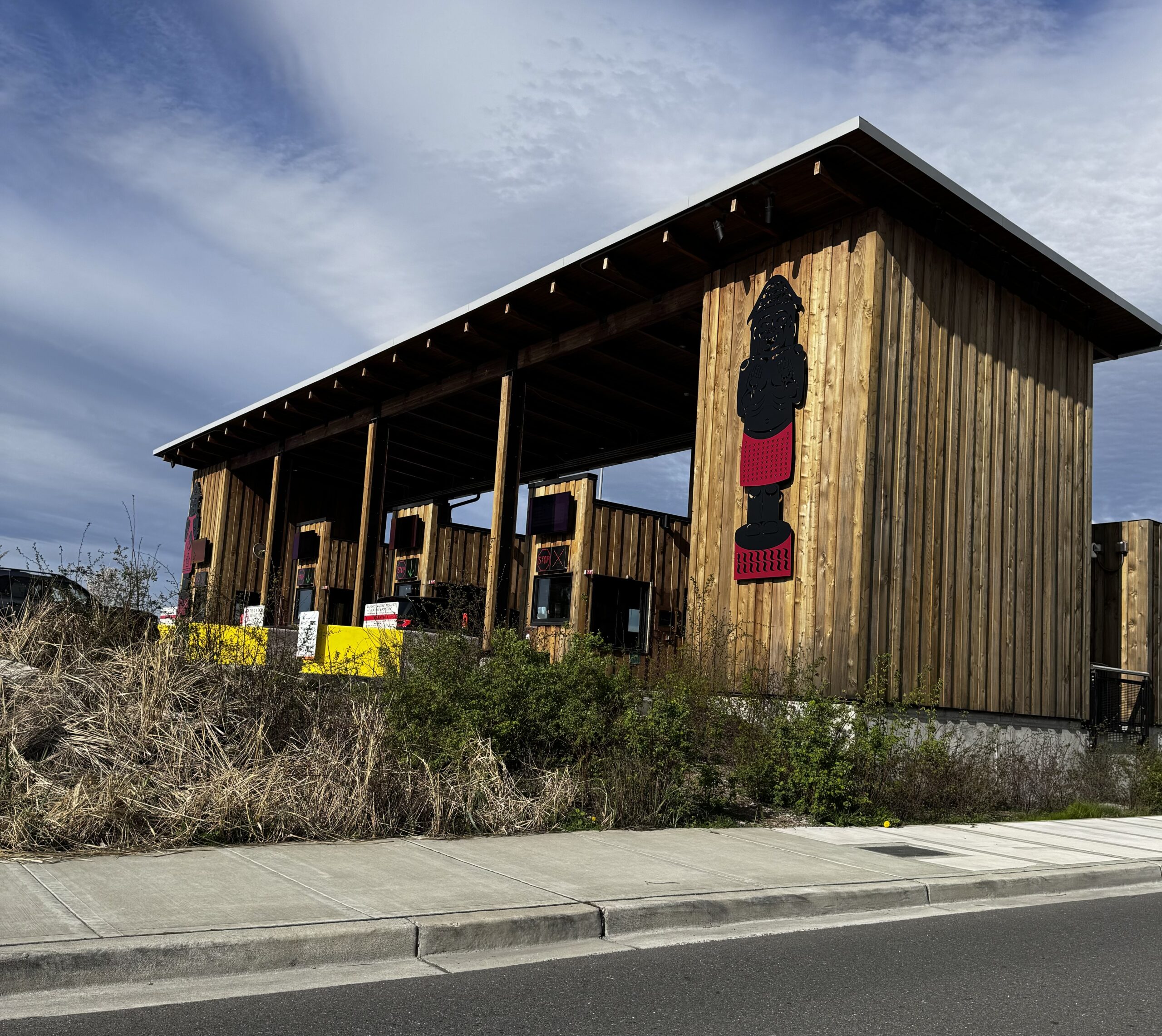
The new Mukilteo ferry terminal
The terminal itself is a work of art, full of works of art. A more in depth look at the history of its construction, the diplomacy that was required to get it built, and the art and history that it represents are worthy of a much longer story than I have space for here, so we’ll look at it in more detail in my Phase 2 of the Puget Sound Loop story coming this summer.
NOAA Research Center
There are signs on fences and trees all over Front Street directing visitors to the National Oceanic and Atmospheric Administration Research Center. Theoretically, it is down a set of steps that lead to the community beach under Ivar’s.
Problem is, if you go looking for it, nothing is there. That’s because after years of promises, at the very last minute the funding to rebuild the facility disappeared. Old agreements stipulated that if NOAA ever abandoned the property, ownership would revert to the Port of Everett.
It’s not that our legislators didn’t try. Several million dollars were spent in the planning and design stage. Renderings produced by Rolluda Architects showed a modern oblong building parallel to the water. The design featured floor-to-ceiling windows and a boat ramp. The research center would have included public access and was initially targeted to open in 2022, as part of the Mukilteo waterfront master plan.
Congress appropriated $4.5 million for the design and initial site work in 2017, and an additional $35.5 million for the completion of the project in 2019. Several times Sen. Patty Murray and Rep. Rick Larsen announced that funding was imminent, and would be released within a couple of months.
Once again, the fickle finger of fate intervened in the form of the pandemic. The very first cost estimates a decade or more ago were in the neighborhood of $20 million By the time construction was actually ready to begin, we were in the midst of post-pandemic supply chain problems and rising inflation. Suddenly, projections soared to what some estimated to be $40 million and the project was scrapped.
Now the city of Mukilteo and the Port of Everett are working to figure out what happens next. Both have developed master plans and are working to combine them to best utilize the property to the benefit of the entire community.
Mukilteo Speedway
I grew up in the Midwest. We had many friends and family in Indiana, where one of the highlights of the year is celebrating the Indianapolis 500 on Memorial Day at the Indianapolis Motor Speedway. I’ve also visited the Daytona International Speedway and the Ontario Motor Speedway. In fact, many of the premier road races around the country are run on motor speedways or superspeedways.
On numerous trips up and down the I-5 corridor I’ve seen the signs for the Mukilteo Speedway. Since I was exploring the community anyway, I decided to check it out and get some pictures. My GPS told me the way to get there was to get on Highway 526. With that left turn out of the airport, I did just that. As I continued down the highway, the voice would periodically say “You have arrived at your destination.”
Talk about confused! I was expecting a huge facility, extensive parking, entry gates, and concessions. I found none of that. I am a bit chagrined to admit that it probably took me 15 minutes to realize that Highway 526 IS the Mukilteo Speedway. And they wonder why the community has a speeding problem!
Boeing’s The Future of Flight
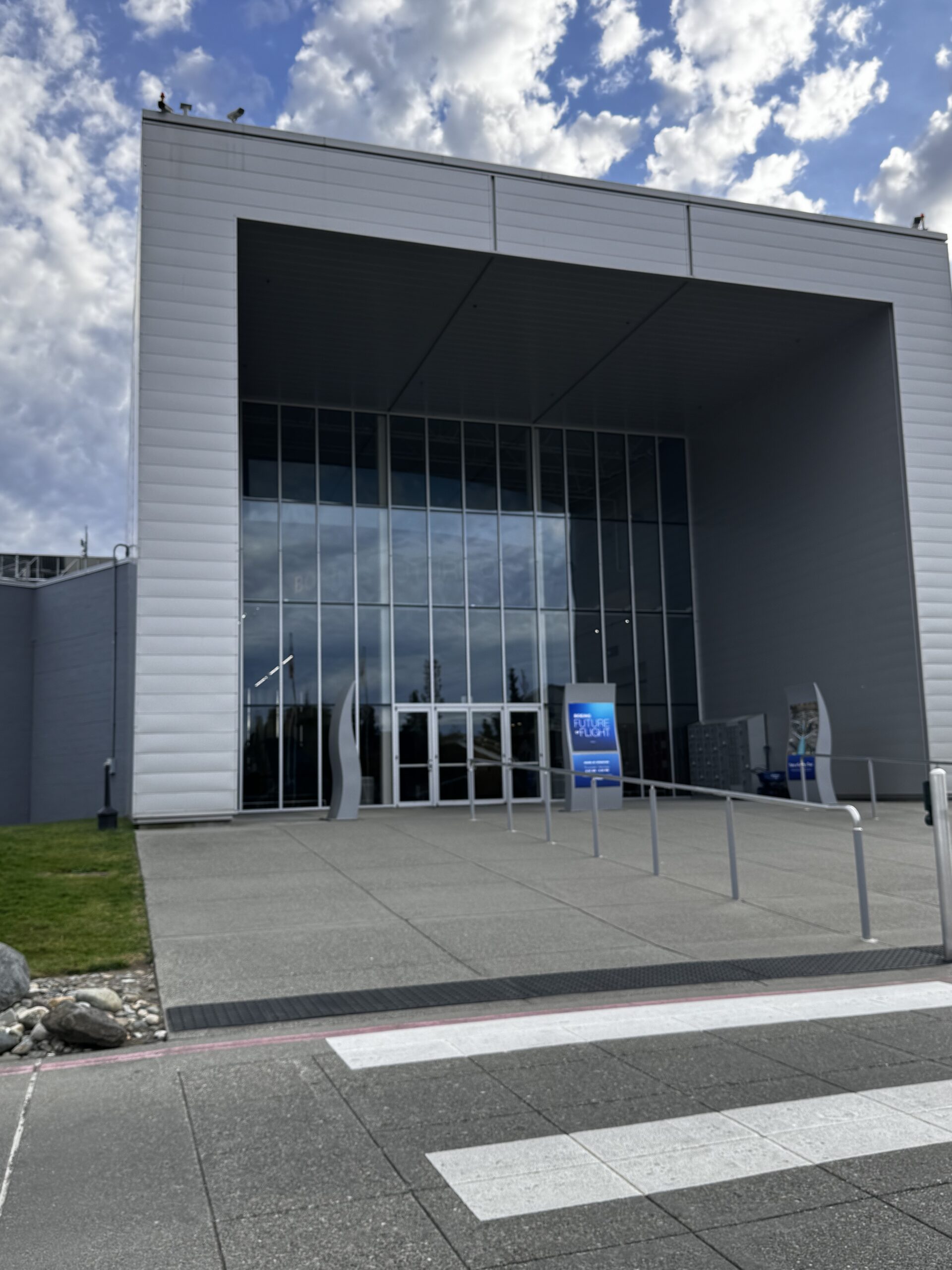
The Boeing Future of Flight Aviation Museum.
If you’re looking for something educational to do while you’re in the area, the Boeing Future of Flight Aviation Museum is a great option. The Future of Flight is an aviation museum that originally opened in December 2005. It is also the starting point for the Boeing Tour which features a portion of the nearby Boeing Factory in adjacent Everett.
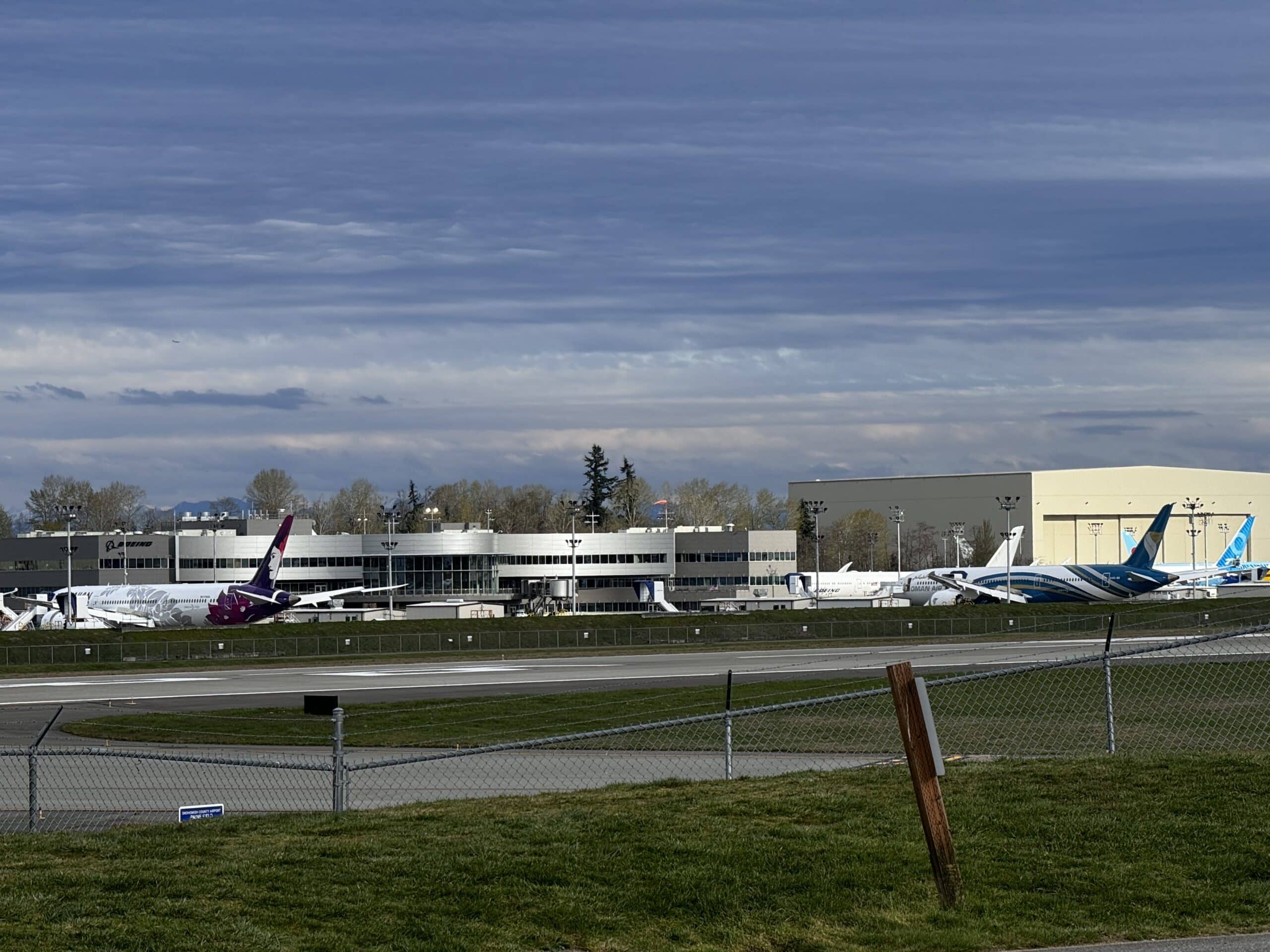
Everett’s Paine Field
Originally conceived as a partnership between Snohomish County, Boeing, Paine Field, and the Museum of Flight, the facility has seen a troubled history. Agreements with the Museum of Flight never materialized, and many of the documents and photographs that were originally planned for the location are now housed elsewhere. The Museum is now owned by Snohomish County and is currently managed by Boeing. Included are a gallery, many exhibits, the Boeing Store, and a cafeteria.
The 80-minute factory tour tickets, which include admission to the museum are $28 to $33. General admission tickets to the museum range from $6 to $12 and do not include the Boeing Tour. Hours are 8:30 to 5:30 Thursday through Monday. More information can be found online at https://www.boeingfutureofflight.com/visit. The Future of Flight is located at 8415 Paine Field Blvd., Mukilteo.
Coming soon
Later this summer we will visit Whidbey Island. Phase 2 of our Puget Sound Loop will include visits to Clinton, Coupeville, Ebey’s Landing, Fort Ebey and Fort Casey.
The southern part of the island is home to two ferry docks — one serves the route that runs between Mukilteo and Clinton, while the other runs between Coupeville and Port Townsend. The former is a 20-minute trip, while the latter is 35 minutes. The distance between the docks is 25.5 highway miles with an estimated travel time of 32 minutes. We all know that a trip by ferry takes a lot longer than just the time on the water, so allow plenty of time. Reservations are recommended and can be made on the Washington State Ferries website.
At some point this fall we will explore Port Townsend, our ultimate destination in Phase 3 of our Puget Sound Loop. A trip to Port Townsend is almost exactly the same time and distance as it takes to get from Gig Harbor to Mukilteo – 68.4 miles/1hr 17 minutes away). There’s so much to see and do there (hint: don’t be surprised if ghosts and haunted mansions, many of them old Victorians, don’t fit into the story somehow).
On one hand, sometimes we just need a day away. If what you’re seeking is a beautiful day on Washington’s roads and a couple of idyllic hours on a ferry, this would be a great way to do it.
On the other hand, if you’re hoping to learn more about three of the many fascinating areas that make our Puget Sound compelling, breaking the trips up may be more your cup of tea. I can’t imagine even coming close to seeing a fraction of what there is to see or doing what there is to do all in one day.
I hope that now that you know all about the adventures that await you on Phase 1, you’ll seriously consider joining us so that we can explore Phases 2 and 3 together.
About the Day Tripper column
Gas prices are sky high, and a night in a hotel is approaching astronomically expensive. So, for the foreseeable future, I imagine many of you are going to find yourselves taking day trips rather than the road trip vacations we’ve grown to love.
This beautiful region in which we live is ripe with opportunities to explore new places, see new things, and learn a little something at the same time. I promise to keep the longest journeys to a one-way distance of under 200 miles. Whether you want to make it an overnight trip, a weekend, or just a very long day trip, we should be able to pull it off.
I hope you’ll grant me the honor of your virtual company as we travel these roads together. Happy trails!
